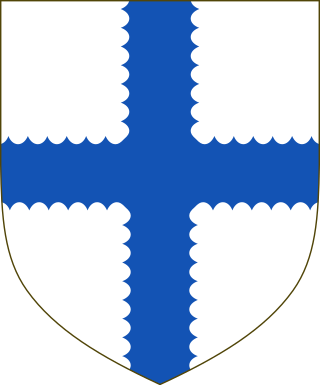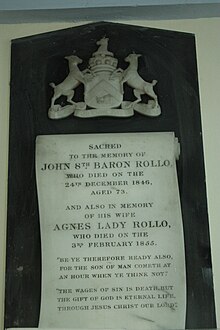
Duke of Atholl, named after Atholl in Scotland, is a title in the Peerage of Scotland held by the head of Clan Murray. It was created by Queen Anne in 1703 for John Murray, 2nd Marquess of Atholl, with a special remainder to the heir male of his father, the 1st Marquess.

Duke of Buccleuch, formerly also spelt Duke of Buccleugh, is a title in the Peerage of Scotland created twice on 20 April 1663, first for James Scott, 1st Duke of Monmouth, and second suo jure for his wife Anne Scott, 4th Countess of Buccleuch. Monmouth, the eldest illegitimate son of King Charles II, was attainted after rebelling against his uncle King James II and VII, but his wife's title was unaffected and passed on to their descendants, who have successively borne the surnames Scott, Montagu-Scott, Montagu Douglas Scott and Scott again. In 1810, the 3rd Duke of Buccleuch inherited the Dukedom of Queensberry, also in the Peerage of Scotland, thus separating that title from the Marquessate of Queensberry.

Marquess of Linlithgow, in the County of Linlithgow or West Lothian, is a title in the Peerage of the United Kingdom. It was created on 23 October 1902 for John Hope, 7th Earl of Hopetoun. The current holder of the title is Adrian Hope.

Earl of Rothes is a title in the Peerage of Scotland. It was created in 1458 for George Leslie, 1st Lord Leslie. He had already been created Lord Leslie in 1445, also in the Peerage of Scotland. His grandson, the third Earl, having only succeeded his elder brother in March 1513, was killed at the Battle of Flodden on 9 September of the same year. His son, the fourth Earl, served as an Extraordinary Lord of Session. Lord Rothes was also tried for the murder of Cardinal Beaton but was acquitted.

Lord Ruthven of Freeland is a title in the Peerage of Scotland. It was created in 1651 for Thomas Ruthven. He was the grandson of Alexander Ruthven, younger son of William Ruthven, 2nd Lord Ruthven. The letters patent creating the peerage is said to have been burnt with the House of Freeland in 1750, and the remainder to the peerage is not accurately known. However, as the dignity was retained on the Union Roll, it has been presumed that the honour was to heirs-general.

Earl of Northesk is a title in the Peerage of Scotland. It was created in 1662 for John Carnegie, who notably served as Sheriff of Forfarshire. He was given the subsidiary title of Lord Rosehill and Eglismauldie at the same time. Carnegie had already been created Earl of Ethie and Lord Lour in 1647 but relinquished those titles in exchange for the 1662 creations. For the purposes of precedence and seniority, the earldom of Northesk is treated as having been created in 1647, the date of the creation of the earldom of Ethie.

Viscount of Oxfuird is a title in the Peerage of Scotland. It was created in 1651 for Sir James Makgill, 1st Baronet, along with the subsidiary title of Lord Makgill of Cousland, also in the Peerage of Scotland, with remainder to his "heirs male of tailzie and provision whomsoever". He had already been created a Baronet, of Makgill, in the Baronetage of Nova Scotia on 19 July 1625, with remainder to heirs male whatsoever. The remainder to heirs male whatsoever was a Scottish concept that permitted inheritance by persons not descended from the original grantee, but descended in the male line from male-line ancestors of the grantee. However, on the death of the first Viscount's son, the second Viscount, the Lordship and Viscountcy were assumed by his daughter Christian, as heir of tailzie and provision. Her son Robert Maitland Makgill also voted as Viscount of Oxfuird at the election of Scottish representative peer in 1733.

Lord Gray is a title in the Peerage of Scotland. The Barony of Gray was created circa July 1445 for the Scottish diplomat and politician Sir Andrew Gray. The first Lord Gray was a hostage in England for the good conduct of James I of Scotland from 1424 to 1427, and was one of the knights who accompanied Lady Margaret Stewart to France for her marriage to Louis XI of France in 1436.

Lord Elphinstone is a title in the Peerage of Scotland created by King James IV in 1510.

Earl of Rosslyn is a title in the Peerage of the United Kingdom. It was created in 1801 for Alexander Wedderburn, 1st Baron Loughborough, Lord Chancellor from 1793 to 1801, with special remainder to his nephew Sir James St Clair-Erskine, as Wedderburn had no surviving issue of his own. Wedderburn had already been created Baron Loughborough, of Loughborough in the County of Leicester, in the Peerage of Great Britain in 1780, with normal remainder to the heirs male of his body, and Baron Loughborough, of Loughborough in the County of Surrey, in the Peerage of Great Britain in 1795, with the same remainder as the earldom. The 1780 barony became extinct upon his death, but the 1795 barony and the earldom passed, by the special remainder, to his nephew, who thus became the second Earl of Rosslyn. The second Earl was a Lieutenant-General in the Army and also held political office as Lord Privy Seal and Lord President of the Council.
Lord Belhaven and Stenton, of the County of Haddington, is a Lordship of Parliament in the Peerage of Scotland. It was created in 1647 for Sir John Hamilton, 2nd Baronet, with remainder to his heirs male.

Lord Sempill is a title in the Peerage of Scotland. It was created in circa 1489 for Sir John Sempill, founder of the collegiate Church of Lochwinnoch. Sempill was killed at the Battle of Flodden in 1513. His grandson, the third Lord, was known as "The Great Lord Sempill". His grandson, the fourth Lord, was Ambassador from King James VI of Scotland to Spain in 1596. The male line failed on the death of his great-grandson, the eighth Lord, in 1684. He was succeeded by his sister Anne, wife of Robert Abercromby, who in 1685 was created Lord Glassford for life. In 1688 she obtained a new charter settling the lordship of Sempill in default of male issue, upon her daughters without division by her then and any future husband. Her younger son, the twelfth Lord, commanded the left wing of the government army at the Battle of Culloden in 1746.

Lord Sinclair is a title in the Peerage of Scotland. According to James Balfour Paul's The Scots Peerage, volume VII published in 1910, the first person to be styled Lord Sinclair was William Sinclair, 3rd Earl of Orkney and 1st Earl of Caithness. However, according to Roland Saint-Clair writing in the late 19th century, William Sinclair's father, Henry II Sinclair, Earl of Orkney, who died in 1420, is the first person recorded as Lord Sinclair by public records.

Lord Napier, of Merchistoun, is a title in the Peerage of Scotland. It was created in 1627 for Sir Archibald Napier, 1st Baronet. Earlier that year, he already held the Napier Baronetcy, of Merchistoun in the County of Midlothian, created in the Baronetage of Nova Scotia. The titles remained united until 1683, when the Baronetcy became dormant. It was revived in the early 19th century and is now held by another branch of the Napier family. Between 1683 and 1686, the Lords of Napier also held the Nicolson Baronetcy, of Carnock in the County of Stirling, and since 1725 the Scott Baronetcy, of Thirlestane in the County of Selkirk, both baronetcies created in the Baronetage of Nova Scotia. The latter is still held today. Additionally, the tenth Lord was created Baron Ettrick, of Ettrick in the County of Selkirk in the Peerage of the United Kingdom on 16 July 1872.

Lord Torphichen or Baron Torphichen is a title in the Peerage of Scotland. It was created by Queen Mary in 1564 for Sir James Sandilands.
Viscount Colville of Culross, in the County of Perth, is a title in the Peerage of the United Kingdom. It was created on 15 July 1902 for the politician and courtier, Charles Colville, 10th Lord Colville of Culross. He had already been created Baron Colville of Culross, in the County of Perth, in 1885, also in the Peerage of the United Kingdom. As of 2018, the titles are held by his great-great-grandson, the fifth Viscount, who succeeded his father in 2010. The fourth Viscount was a judge and politician. Lord Colville of Culross was one of the ninety elected hereditary peers that remained in the House of Lords after the passing of the House of Lords Act 1999, and sat as a crossbencher.

Baron Inchiquin is one of the older titles in the Peerage of Ireland. It was one of two titles created on 1 July 1543 for Murrough O'Brien, Prince of Thomond, who claimed descent from Brian Boru, a High King of Ireland. The English titles were granted under the policy of surrender and regrant, and therefore conditional upon the abandonment of any Irish titles, the adoption of English customs and laws, pledging of allegiance to the Crown, apostasy from the Catholic Church, and conversion to the Church of Ireland. Murrough was made both Earl of Thomond in the Peerage of Ireland, with remainder to his nephew Donough O'Brien and Baron Inchiquin, with remainder to his male heirs. Following the death of his cousin, Conor Myles John O' Brien in June 2023, Conor John Anthony O' Brien is currently the 19th Baron Inchiquin
Baron Addington, of Addington in the County of Buckingham, is a title in the Peerage of the United Kingdom. It was created on 22 July 1887 for the businessman and Conservative Member of Parliament, John Hubbard. He was head of the firm of John Hubbard & Co and also sat as a Member of Parliament for Buckingham and the City of London. His eldest son, the second Baron, was a partner in the family firm and represented Buckingham in the House of Commons as a Conservative. He was succeeded by his eldest son, the third Baron. He was three times Mayor of Buckingham. On the death of his younger brother, the fourth Baron, the line of the eldest son of the first Baron failed. The title passed to their first cousin once removed, the fifth Baron. He was the grandson of Cecil John Hubbard, third son of the first Baron. As of 2018, the title is held by his eldest son, the sixth Baron. He is one of the ninety elected hereditary peers that remain in the House of Lords after the passing of the House of Lords Act of 1999. Lord Addington sits on the Liberal Democrat benches.

Baron Brougham and Vaux, of Brougham in the County of Westmorland and of High Head Castle in the County of Cumberland, is a title in the Peerage of the United Kingdom. It was created in 1860 for Henry Brougham, 1st Baron Brougham and Vaux, a lawyer, Whig politician, and formerly Lord Chancellor, with remainder to his younger brother William Brougham. He had already been created Baron Brougham and Vaux, of Brougham in the County of Westmorland, in 1830, also in the Peerage of the United Kingdom, with normal remainder to the heirs male of his body.

Clan Rollo is a Lowland Scottish clan seated at Pitcairns House, Perthshire. The Chief of the Clan is styled Lord Rollo.















